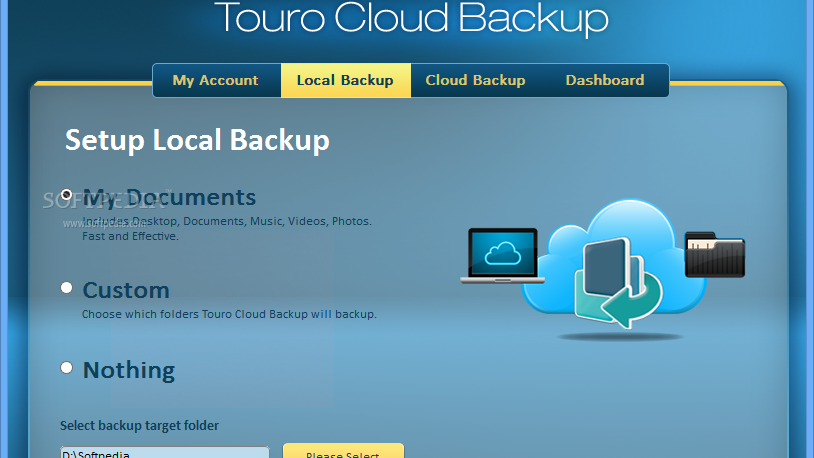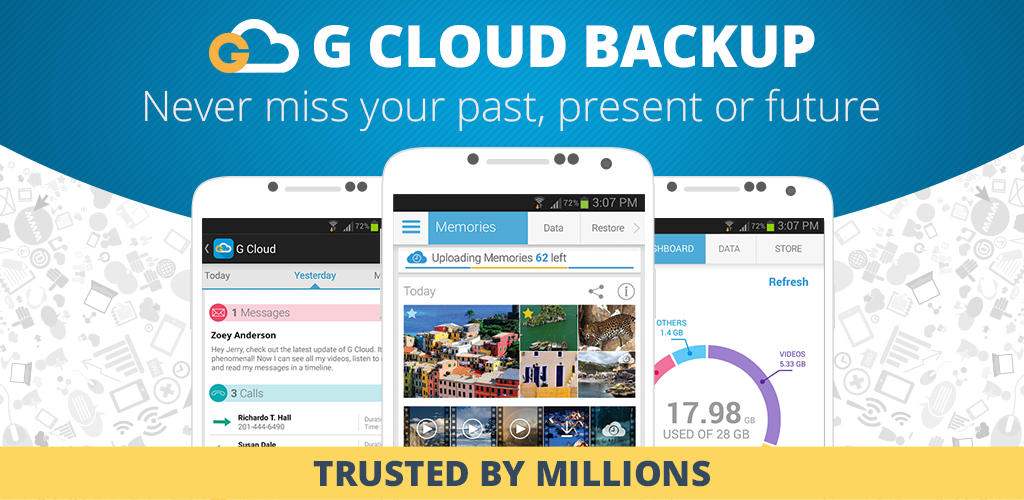A remote, online, or managed backup service, sometimes marketed as cloud backup or backup-as-a-service, is a service that provides users with a system for the backup, storage, and recovery of computer files. Online backup providers are companies that provide this type of service to end users (or clients). Such backup services are considered a form of cloud computing.
Online backup systems are typically built around a client software program that runs on a schedule, typically once a day, and usually at night while computers aren't in use. This program typically collects, compresses, encrypts, and transfers the data to the remote backup service provider's servers or off-site hardware.
There are many products on the market - all offering different feature sets, service levels, and types of encryption. Providers of this type of service frequently target specific market segments. High-end LAN-based backup systems may offer services such as Active Directory, client remote control, or open file backups. Consumer online backup companies frequently have beta software offerings and/or free-trial backup services with fewer live support options.

History
In the mid-1980s, the computer industry was in a great state of change with modems at speeds of 1200 to 2400 baud, making transfers of large amounts of data slow (1 MB in 72 minutes). While faster modems and more secure network protocols were in development, tape backup systems gained in popularity. During that same period the need for an affordable, reliable online backup system was becoming clear, especially for businesses with critical data.
Remote Backup Systems, formerly known as Quantum Tech and founded in 1987 by Rob Cosgrove, was the first company to offer remote backup solutions to service providers and still operates to this day. Also in 1987 he wrote the first book on remote backup services, The RBS Book: How to Start and Operate a Remote Backup Data Service.
More online/remote backup services came into existence during the heyday of the dot-com boom in the late 1990s. The initial years of these large industry service providers were about capturing market share and understanding the importance and the role that these online backup providers were playing in the web services arena. Today, most service providers of online backup services position their services using the SaaS (software as a service) strategy and its relevance is predicted to increase exponentially in the years to come as personal and enterprise data storage needs rise. The last few years have also witnessed a healthy rise in the number of independent online backup providers.
How Do I Backup To The Cloud Video
Characteristics
Service-based
- The assurance, guarantee, or validation that what was backed up is recoverable whenever it is required is critical. Data stored in the service provider's cloud must undergo regular integrity validation to ensure its recoverability.
- Cloud BUR (BackUp & Restore) services need to provide a variety of granularity when it comes to RTO's (Recovery Time Objective). One size does not fit all either for the customers or the applications within a customer's environment.
- The customer should never have to manage the back end storage repositories in order to back up and recover data.
- The interface used by the customer needs to enable the selection of data to protect or recover, the establishment of retention times, destruction dates as well as scheduling.
- Cloud backup needs to be an active process where data is collected from systems that store the original copy. This means that cloud backup will not require data to be copied into a specific appliance from where data is collected before being transmitted to and stored in the service provider's data centre.
Ubiquitous access
- Cloud BUR utilizes standard networking protocols (which today are primarily but not exclusively IP based) to transfer data between the customer and the service provider.
- Vaults or repositories need to be always available to restore data to any location connected to the Service Provider's Cloud via private or public networks.
Scalable and elastic
- Cloud BUR enables flexible allocation of storage capacity to customers without limit. Storage is allocated on demand and also de-allocated as customers delete backup sets as they age.
- Cloud BUR enables a Service Provider to allocate storage capacity to a customer. If that customer later deletes their data or no longer needs that capacity, the Service Provider can then release and reallocate that same capacity to a different customer in an automated fashion.
Metered by use
- Cloud Backup allows customers to align the value of data with the cost of protecting it. It is procured on a per-gigabyte per month basis. Prices tend to vary based on the age of data, type of data (email, databases, files etc.), volume, number of backup copies and RTOs.
Shared and secure
- The underlying enabling technology for Cloud Backup is a full stack native cloud multitenant platform (shared everything).
- Data mobility/portability prevents service provider lock-in and allows customers to move their data from one Service Provider to another, or entirely back into a dedicated Private Cloud (or a Hybrid Cloud).
- Security in the cloud is critical. One customer can never have access to another's data. Additionally, even Service Providers must not be able to access their customer's data without the customer's permission.
Enterprise-class cloud backup
An enterprise-class cloud backup solution must include an on-premise cache, to mitigate any issues due to inconsistent Internet connectivity.
Hybrid cloud backup is an approach combining local backup for fast backup and restore, along with off-site backup for protection against local disasters.
Hybrid cloud backup works by storing data to local disk so that the backup can be captured at high speed, and then either the backup software or a D2D2C (Disk to Disk to Cloud) appliance encrypts and transmits data to a service provider. Recent backups are retained locally, to speed data recovery operations. There are a number of cloud storage appliances on the market that can be used as a backup target, including appliances from CTERA Networks, StorSimple and TwinStrata.
Recent improvements in CPU availability allow increased use of software agents instead of hardware appliances for enterprise cloud backup. The software-only approach can offer advantages including decreased complexity, simple scalability, significant cost savings and improved data recovery times. Examples of no-appliance cloud backup providers include Intronis, Zetta.net and cloudHQ.

Typical features

Common features for business users
Cost factors
Online backup services are usually priced as a function of the following things:
- The total amount of data being backed up.
- The number of machines covered by the backup service.
- The maximum number of versions of each file that are kept.
- Data retention and archiving period options
- Managed backups vs. Unmanaged backups
- The level of service and features available
Some vendors limit the number of versions of a file that can be kept in the system. Some services omit this restriction and provide an unlimited number of versions. Add-on features (plug-ins), like the ability to back up currently open or locked files, are usually charged as an extra, but some services provide this built in.
Most remote backup services reduce the amount of data to be sent over the wire by only backing up changed files. This approach to backing up means that the customers total stored data is reduced. Reducing the amount of data sent and also stored can be further drastically reduced by only transmitting the changed data bits by binary or block level incremental backups. Solutions that transmit only these changed binary data bits do not waste bandwidth by transmitting the same file data over and over again if only small amounts change.

Advantages
Remote backup has advantages over traditional backup methods:
- Remote backup does not require user intervention. The user does not have to change tapes, label CDs or perform other manual steps.
- Unlimited data retention (presuming the backup provider stays in business).
- Some remote backup services will work continuously, backing up files as they are changed.
- Most remote backup services will maintain a list of versions of your files.
- Most remote backup services will use a 128 - 448 bit encryption to send data over unsecured links (e.g. internet)
- A few remote backup services can reduce backup by only transmitting changed data

Disadvantages
Remote backup has some disadvantages over traditional backup methods:
- Depending on the available network bandwidth, the restoration of data can be slow. Because data is stored offsite, the data must be recovered either via the Internet or via a disk shipped from the online backup service provider.
- Some backup service providers have no guarantee that stored data will be kept private.
- It is possible that a remote backup service provider could go out of business or be purchased, which may affect the accessibility of one's data or the cost to continue using the service.
- If the encryption password is lost, data recovery will be impossible. However, with managed services this should not be a problem.
- Residential broadband services often have monthly limits that preclude large backups. They are also usually asymmetric; the user-to-network link regularly used to store backups is much slower than the network-to-user link used only when data is restored.
- In terms of price, when looking at the raw cost of hard disks, remote backups cost about 1-20 times per GB what a local backup would.
Managed vs. unmanaged
Some services provide expert backup management services as part of the overall offering. These services typically include:
- Assistance configuring the initial backup
- Continuous monitoring of the backup processes on the client machines to ensure that backups actually happen
- Proactive alerting in the event that any backups fail
- Assistance in restoring and recovering data
Scheduled vs. Manual Backup
There are 2 distinct types of backup modes, scheduled and manual.
- Scheduled Backup - data is backed up according to a fixed schedule.
- Manual Backup - backup of data is triggered by user input.
Are You Looking for Products
Here some products related to "Remote Backup Service".
HGST Touro Desk Pro HTOLD..
G Cloud Backup: Appstore ..
B007DAJWXQ-img1l.jpg..
Pyle PLCM4300WiR Vehicle ..
Get these at Amazon.com* amzn.to is official short URL for Amazon.com, provided by Bitly
Source of the article : here






EmoticonEmoticon